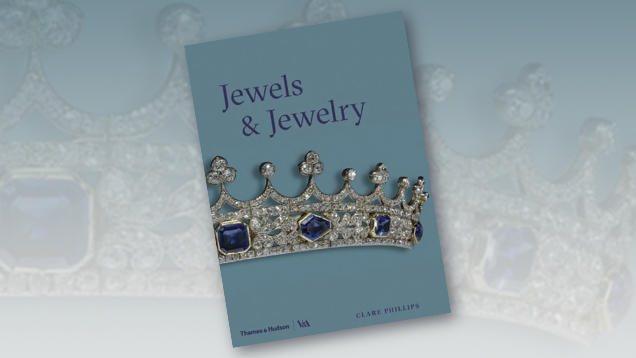Book Review: Jewels & Jewelry

Jewels & Jewelry by Clare Phillips is a colorful depiction of the evolution of jewelry and accessories in Western civilization. The book is outlined in three parts and brings the reader on an educational journey using the pieces that are on display at the London’s Victoria and Albert Museum. Phillips’s writing—with accompanying photographs—reinforces that the jewelry industry is ever changing and influenced by popular culture.
Phillips starts out by discussing the common materials that will be found in the pieces, from metals to the gemstones and enamels that decorate them. From there, Phillips goes in chronological order, from the Middle Ages to today, showing how styles have changed. She describes how expeditions and conquerors returned to Europe with new materials and important gemstones from newly discovered sources, how the evolution of machinery allowed for mass production of jewelry pieces, and how the availability of goods was affected during the world wars due to restrictions on materials like platinum and certain gold. The final part discussed the manufacturing and distribution pieces in regards to the use of hallmarks and the design aspects of shops. Phillips mentions the importance of a jewelry’s history, due to the common practice of recycling metals and re-cutting and re-setting stones. Documentation of items (i.e., hallmarks and portraits) help to keep its history.
The high-quality photographs of the jewelry and accessories were carefully chosen to complement the passages. The evolution of gem cutting, from simple facets to round brilliants, is apparent in these pieces. Phillips also used paintings from the seventeenth through nineteenth centuries to show how people wore the jewelry and how styles have changed. For instance, she discusses the design aspect of Queen Victoria’s coronet in 1842 and then how it was restyled in the 1920s to be worn lower on the brow.
The book itself was quite easy to follow along for those with a basic jewelry background. The three sections succeeded in getting their concept across: materials, evolution of style, and distribution. The materials section gave just the right amount of information for the reader to understand what would be brought up later in the style section. Phillips brings in key players of the jewelry world, such as Fabergé and Cartier, but balances them out with lesser-known but equally important artists, such as Arthur and Georgie Gaskin and Alexander Calder. She also depicts the influencers who popularized jewelry styles: Monarchs of the seventeenth and eighteenth century, those involved in the post-war surrealism movements in the twentieth century, to celebrities such as Beyoncé in the twenty-first century.
When going through Jewels & Jewelry, keep in mind that its focus is on pieces from Western civilization pieces (i.e., the UK, Germany, and America). However, this is a great book to use to understand how goods and ideas are transferred from one country to the next. For instance, Phillips points out how the opening of the Japanese ports in the 1850s and the creation of the Indian Museum in 1801 that housed goods collected by the British East India Company introduced new concepts and inspired jewelers and artists alike.
If you are looking for a book that has a vast number of intricate pieces—from brooches to cigarette cases—and the history behind them, Jewels & Jewelry should be a top pick.



